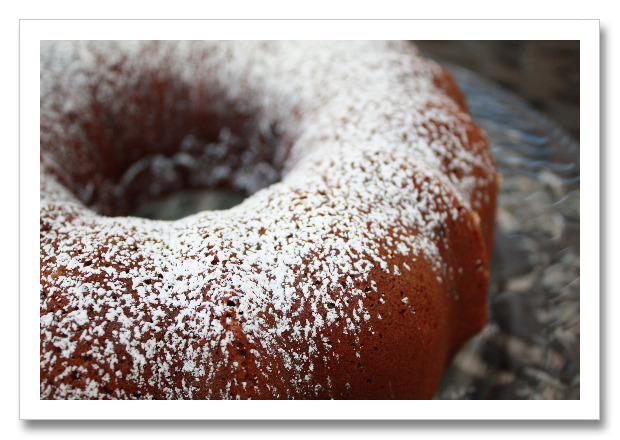
It all started because I had a craving for something chocolate. I do my best to suppress it, but it gets the better of me now and then and there’s nothing much for it except to bake something. Something chocolate.
Well so anyway, I was reading a blog about a loaf chocolate cake. One thing led to another and I was researching an article in the New York Times about a chocolate cake and by golly, I have the cookbook from which this cake originates. Maida Heatter’s Book of Great Chocolate Desserts, it’s a treasure-trove of chocolate recipes of every type. I’ve had the book for years and rarely seem to refer to it. Shame on me!
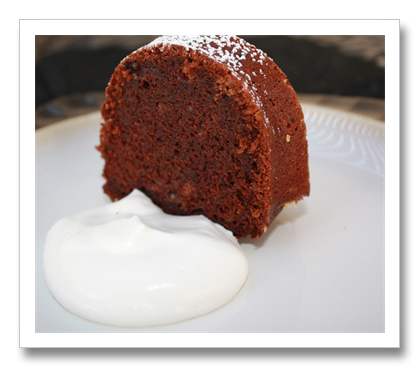
It seems like I’ve cooked/baked a lot recently with bourbon. I really don’t drink it much, but it must be that flavor interests me at the moment. So many desserts of the South incorporate bourbon. And then there was the Kentucky Derby recently, and we attended a party where mint juleps were served. I drank two. TWO! Oh my goodness, but they were good. Must be the little bit of simple syrup in them plus the shaved ice (not cubes, mind you, but shaved pieces) and the fresh mint. So, yes, I guess I do drink bourbon every now and again. It was the first hard liquor drink I tasted when I was 21 (yeah, I didn’t drink until then – not because I was abiding by law – but because I wasn’t around people who did drink – beer was the drink of choice with a few of my college pals but I didn’t like beer). Anyway, my former father-in-law was a bourbon-and-7-up imbiber and he would make me really mild ones on rare occasions when we’d visit him. Always mwade with Jim Beam.
Back to cake . . . reading a few other websites and blogs indicated this was a five-star recipe, so since I had all the ingredients (yea!) I went for it. It can be made in either a Bundt cake or a tube pan. I opted for the Bundt just because it’s prettier. Maida includes this in a chapter of Old-Fashioned Cakes Without Icing. The cake batter is different in only one aspect – you alternate the dry ingredients with the coffee/bourbon liquid, and it makes a very liquid batter. No matter how low/slow I turned my stand mixer, and how slowly I dribbled in the coffee mixture, it spewed thin batter all over everywhere – the mixer, the counter, the cabinets, my apron and even my shoe, dad gum it! And there are dribbles on my hardwood floor that I haven’t yet mopped up. I didn’t notice those and now they’re dried. I should have used the plastic cover I have for my stand mixer. I never use it, but it would have worked well if I had! So, you’re warned, okay?
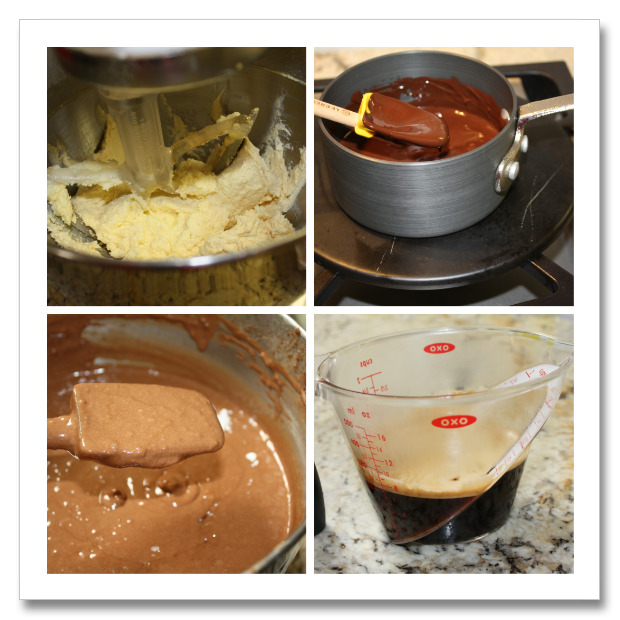
The cake is baked in a slow oven (325) for over an hour (70-75 minutes recommended). It makes a deliciously light cake, and nicely rich with chocolate. I used 70% chocolate for this to get that super dark chocolate flavor. I melted the chocolate in a little pan I have and placed it on top of a flame tamer. That’s one of those things that allows for a slower heat to a pan (top right photo in collage above) – you place it over the range burner and put your cooking pan on top. I used my smallest/lowest gas burner and turned it down to the lowest flame. It took about 10 minutes to melt, and it didn’t burn at all. One of those great little items for your kitchen that pays for itself when you need it.
My only advice about making this cake – do use very finely crushed dry bread crumbs for the cake pan. All I had in my pantry was panko. And now you know, even panko crumbs stay crisp after being in contact with a cake batter! It didn’t really detract from the cake – at first I thought it was just the outer edge of cake that had become crispy. Uhm. No. Panko. Light colored little flecks of panko. So, be warned about that!
Once the cake is baked, you let it rest for 15 minutes, then turn it out (over) onto a rack to cool completely. You can poke a few holes and drizzle more bourbon on it, if you like (I didn’t). And once totally cool, sprinkle the top with powdered sugar. According to Maida’s recipe, you can also substitute rum, Cognac, Scotch or Amaretto for the bourbon. The recipe was a favorite of hers to demonstrate at cooking classes, and the feedback she got was that everyone couldn’t wait to go home and make it. That’s surely good reason to make this cake! Do serve it with whipped cream, or vanilla ice cream. Or maybe a glass of iced-cold milk. Well – the taste – oh my goodness – was it good. The lightest crumb. Just the lightest I’ve ever had in a cake. Worth making? Absolutely. Will I make it again. A resounding YES.
Maida Heatter’s 86-Proof Chocolate Cake
Recipe By: Adapted from “Maida Heatter’s Book of Great Chocolate Desserts”
Serving Size: 12
NOTES: With smaller portions this would easily serve 16. Use very light, fine bread crumbs for this. You can also use real espresso (very strong) for the espresso powder (mixed with water). I used part decaf espresso, part decaf coffee granules and added cold water for the required liquid amount. I used a 10-inch bundt, which worked fine, but the cake was not as tall.
butter for greasing cake pan (use ample)
1/3 cup dry bread crumbs — (approximately), very fine
5 ounces unsweetened chocolate — (5 squares)
2 cups sifted all-purpose flour
1 teaspoon baking soda
1/4 teaspoon salt
1/4 cup espresso powder — (or substitute prepared espresso for the water)
boiling water cold water
1/2 cup bourbon
1/2 pound unsalted butter
1 teaspoon vanilla extract
2 cups granulated sugar
3 large eggs
Additional bourbon (optional)
Confectioner’s sugar (optional)
1. Adjust rack one-third up from bottom of the oven and preheat oven to 325 degrees. Butter well the inside of a 9-inch bundt pan (called a mini-bundt pan), or any other fancy tube pan with a 10-cup capacity, and dust with fine dry breadcrumbs. Invert the pan over a piece of paper and tap lightly to shake out excess crumbs. Set aside.
2. Place the chocolate in the top of a small double boiler over hot water on low heat. Cover and cook only until melted; then remove the top of the double boiler and set it aside, uncovered, to cool slightly.
3. Sift together the flour, baking soda and salt and set aside.
4. In a two-cup measuring cup dissolve the coffee in a little boiling water. Add cold water to the 1 1/2 cup line. Add the bourbon. Set aside.
5. Cream the butter in the large bowl of an electric mixer. Add the vanilla and sugar and beat to mix well. Add the eggs one at a time, beating until smooth after each addition. Add the chocolate and beat until smooth.
6. Then, on low speed, alternately add the sifted dry ingredients in three additions with the liquids in two additions, adding the liquids VERY gradually to avoid splashing. Scrape the bowl with a rubber spatula after each addition. Be sure to beat until smooth after each addition, especially after the last. It will be a thin mixture.
7. Pour the mixture into the prepared pan. Rotate the pan a bit briskly, first in one direction, then in the other, to level the top. In a minibundt pan the batter will almost reach the top of the pan, but it will not run over and you will have a beautifully high cake.
8. Bake for one hour and 10 to 15 minutes. Test by inserting a cake tester in the middle of the cake and bake only until the tester comes out clean and dry.
9. Cool in the pan for about 15 minutes. Then cover with a rack and invert. Remove the pan, sprinkle the cake with a little optional bourbon, and leave the cake upside down on a rack to cool. Before serving, if you wish, sprinkle the top with confectioners’ sugar through a fine strainer. Serve with whipped cream or vanilla ice cream.
Per Serving: 455 Calories; 23g Fat (46.8% calories from fat); 6g Protein; 54g Carbohydrate; 2g Dietary Fiber; 94mg Cholesterol; 198mg Sodium.
A year ago: Scenery in Glacier Bay (Alaska)
Two years ago: Potato Salad



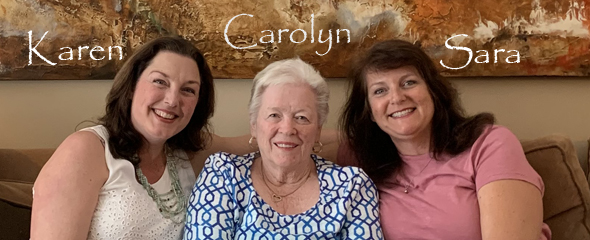
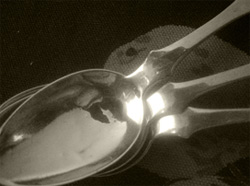

hddonna
said on July 9th, 2010:
You told me this was coming, and I am definitely going to make it! You know, I have that book, too, and I love it. I’ve made various recipes from it over the years, but hadn’t taken note of this one, so thank you for bringing my attention to it! I like that it’s a bundt cake–I’ve been gravitating more towards those lately.
My favorite recipe from Maida Heatter’s book is the chocolate shortbread. I make several batches every Christmas, but instead of rolling it out and cutting it, I make little balls and press them down with my cookie stamps, of which I have a dozen or so in Christmas designs. They’re my easiest Christmas cookie and a family favorite.
Thanks, Donna. I’ll have to go look up the shortbread recipe. I would think of making chocolate shortbread, but with your recommendation I’ll have to try it – maybe for next Christmas. . . carolyn t
hddonna
said on July 18th, 2010:
I made the cake, and we’ve been eating it for several days, with homemade ice cream. This cake is amazing. It is incredibly moist but not heavy and dense–just melts in your mouth! I forgot it overnight on the cooling rack, and it didn’t hurt it at all. The breadcrumbs work amazingly well. I have a bundt pan with very narrow, sharp ridges, and things tend to stick. With the crumbs, it slipped right out. They kind of meld with the crust, too, so it isn’t obvious that they were used. This is the best chocolate bundt cake recipe I have tried.
So glad you liked it. I still have a small chunk in the freezer and will look forward to having the last of this. It really is a fantastic tasting cake! . . . carolyn t